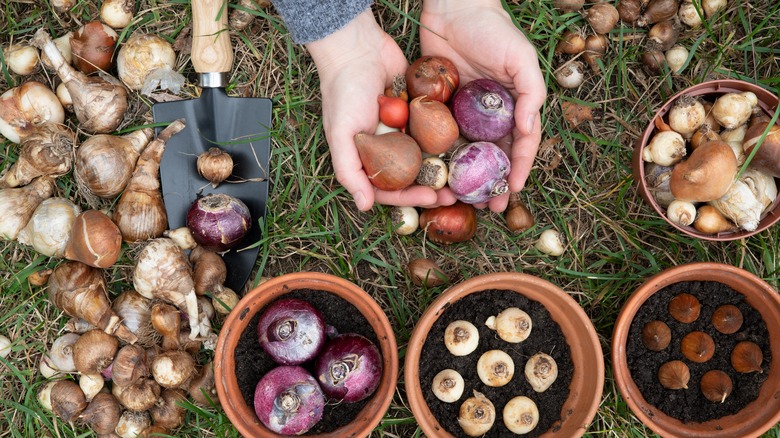Here's What It Means To Lift Tulip Bulbs And How Often You Should Do It
Tulips are beautiful flowers to add to your garden so you can get into the warm weather spirits when the snow is starting to melt. They emerge before your other flowers as winter passes and can continue blooming until late spring. Tulips do well across the U.S. but prefer the mountainous west because of its colder climate. You could even grow them indoors if you wish, and they are perfect for cutting and using in floral arrangements.
Tulips are perennials, meaning they will grow back every year, however, their bulbs can struggle to emerge the following season if they're not in the right environment. Tulips need sandy soil that drains well and, depending on your weather, they may need a shady spot in your yard to keep them cool. If your tulips aren't growing back every year, a simple solution is to lift and remove the bulbs from the ground so they can dry out and then be replanted later in the season. Otherwise, you'll be stuck purchasing new bulbs every spring when you shouldn't have to.
Should you lift tulip bulbs?
Most gardeners in the U.S. don't have to worry about lifting bulbs when growing tulips unless they notice problems. Therefore, it isn't a necessary step, but it does help your plant's overall health. If your garden often becomes water-logged, you should lift them to prevent rot. Some people have successfully grown tulips for years without removing them and then notice a stunt in the next year's blooms, or they don't return at all. In this case, the soil has likely become overcrowded by the bulbs and their new growth. Lifting, or removing, them from the ground every winter would fix this problem.
Removing tulip bulbs is also an excellent way to prevent your plants from being injured while they're dormant. For example, they could develop frost damage if you leave them in the ground during winter. This is even more likely to happen if your yard is exposed to extremely cold weather. Your local wildlife may also find the tulip bulbs delicious and dig them up when looking for a bite to eat. Overall, lifting the bulbs after they've bloomed and they're ready to become dormant is better than leaving them in your garden.
How to lift and store tulip bulbs
Lifting your tulip bulbs is just as easy as planting them. The ideal time to start the process is after they've bloomed. The greenery will die in the following few weeks, signaling they're safe to lift. You don't want to do it any earlier, or the bulbs won't be able to absorb all the nutrients they need for the next season. Once your tulips are ready, take your trowel and dig around each bulb, aiming to go about 8 inches into the earth. Then pull them out of the ground and gently shake off the excess soil. With a clean pair of shears, trim off any remaining dead foliage.
Next, you'll need to dry them out to store them safely. There are many different materials you can wrap them with while they are drying. You can use burlap sacks, paper, produce nets, pantyhose, or a box of peat. Although, the best way to prevent them from getting moldy is by choosing a material that allows for sufficient air circulation. After a few days, they'll be ready for storage. Once dry, you can collect them in a box and keep them in your refrigerator or garage, provided it's a location that remains cold and dark. If you refrigerate them, keep them at around 45 degrees Fahrenheit. Ideally, you should replant the tulip bulbs within six months, but they can last up to a year in storage.


